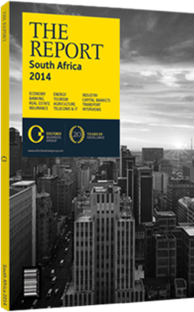Despite significant challenges, the country has competitive advantages to move forward
The South African economy grappled with headwinds in early 2014, although it did avoid a recession in the second quarter of the year. The country’s long-term fundamentals remain fairly attractive, but the new cabinet still faced a tricky job of stimulating growth over the remainder of the year. The economy grew 0.6% in the second quarter of 2014, after shrinking by an annualised 0.6% in the first quarter, its first contraction since 2009. While it dodged a recession, defined as two consecutive quarters of economic contraction, second-quarter growth was weaker than expected.
The longest mining strike in the country’s history severely knocked GDP growth. Mining accounts for around two-thirds of South Africa’s exports and thus the country was hit hard by an 18-week strike by more than 70,000 workers at platinum mines, which led to the biggest drop in mining output for nearly half a century. Labour negotiations between trade unions and the private sector have long been difficult in South Africa, but the strike over working conditions and wages cost the world’s three biggest platinum producers an estimated $2.2bn in revenue. Even though the dispute has been formally resolved, it will take some time for the mine’s operations to be brought up to peak levels again.
Revised Growth Figures
The poor performance in early 2014 naturally affected full-year forecasts. The central bank, the South African Reserve Bank (SARB), dropped its growth forecast in September 2014 to 1.5% from 1.7% previously, which falls below the previous year’s 1.9%. SARB is working on a delicate balancing act in managing both the need to stoke growth and keep a limit on inflation. The bank has raised its key interest rate twice so far in 2014 to 5.75%, and further hikes are likely. SARB governor Gill Marcus raised full-year inflation forecasts to 6.3% in July 2014. While inflation has been eroding real incomes, the rate increases to offset it has damaged growth, Abbas Ameli-Renani, an emerging-markets strategist at RBS, said in a note. Domestic consumption in recent years has been one of the primary drivers of the economy in South Africa. “It is very clear that the private consumption side of the economy is also very weak, and that it took a big hit from the rate hike in January,” Ameli-Renani wrote.
Looking To Small Businesses
The short-term outlook is challenging and has been since the onset of the global financial crisis, which saw the country – which is closely integrated into global trade and capital flows – left unusually exposed to drops in demand. Slowing demand from China and the eurozone – two of South Africa’s largest trading partners – hit export volumes in the first quarter of 2014. But there are also structural issues that South Africa’s Gini coefficient, an indicator of income disparity where 0 reflects complete equality and 1 reflects complete inequality, remains among the world’s highest – at around 0.7. The country is also facing a double deficit that has seen the country singled out as one of the world’s “fragile five” emerging economies. And while infrastructure networks are competitive on a regional basis, bottlenecks – particularly in the power sector – have also slowed output and unemployment remains stubbornly high, rising to 25.5% in the second quarter of 2014.
As a result, navigating the economy out of its current delicate situation is a priority for South Africa’s recently re-elected government. In May 2014 President Jacob Zuma was sworn in for a second term, and pledged to focus on the economy and tackle inequality. Among other initiatives, a new small business ministry has been established to bolster activity among the numerous small and medium-sized enterprises.
Ultimately, while South Africa’s challenges are by no means marginal, the country continues to present some competitive advantages. Agricultural production rose nearly 5% in the second quarter of 2014, buoyed by bumper grain harvests. It also continues to boast the continent’s strongest financial sectors and infrastructure networks. It has a large and robust private sector, which in recent years has been expanding rapidly into other African markets. But it will need to leverage these traits to ride out the current short-term turbulence.
You have reached the limit of premium articles you can view for free.
Choose from the options below to purchase print or digital editions of our Reports. You can also purchase a website subscription giving you unlimited access to all of our Reports online for 12 months.
If you have already purchased this Report or have a website subscription, please login to continue.

